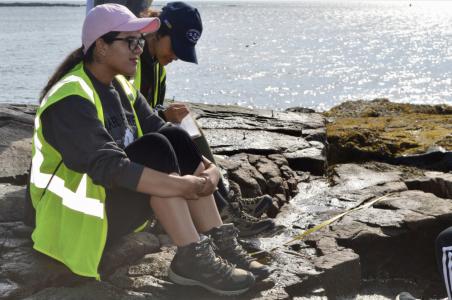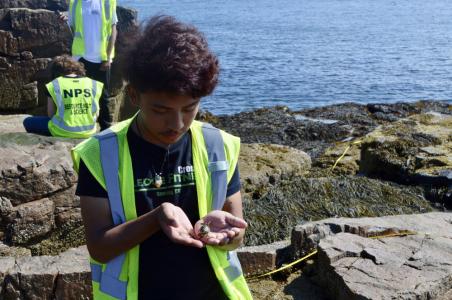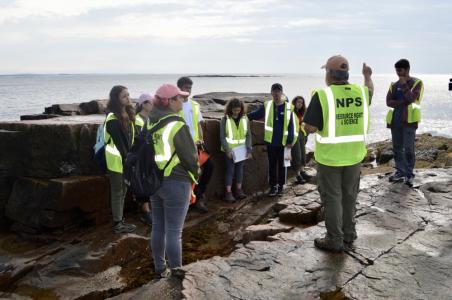.
From Students to Scientists, An Earthwatch Metamorphosis
By Catie Mino, Earthwatch Academic Facilitator
Acadia National Park sits on the rocky granite coastline of Maine. It covers approximately 47,000 acres and is home to a wide variety of plants, wildlife, and ocean biomes. It was also the hub for our research project—Climate Change: Sea to Trees at Acadia National Park. Our mission was to study the effects of climate change and ocean acidification on the intertidal zone. Our team consisted of one scientist, two academic facilitators, and nine students. The students were chosen to participate on the expedition as part of Earthwatch’ Ignite student fellowship program. Arriving at Maine’s Schoodic Peninsula from Los Angeles, California, they were in awe of the new terrain and climate. They danced in a rainstorm and their excitement pervaded the research we undertook.
.
.
The intertidal zone is an endless place of discovery. Hidden for half of every day, the zone is only exposed when low tide is reached. During those hours, seaweed fields, tidal pools, and rocks emerge. On our first day in the field, students were cautious to walk over the slippery rocks or peel back the layers of seaweed in search of sea critters. However, as we visited these areas each day, they became more and more comfortable with the new terrain. Some students dug through seaweed and tidal pools for the invasive green crab species. Others used GPS and compasses to direct the group to our next location.
The students were very busy, starting each day at 7:00 a.m. The tides dictated the flow of their day. It was not all work, however. Together we went hiking, watched the sunset, played games, and enjoyed a lobster dinner. Each day during low tide we would visit the intertidal zone. Four quadrats were established in these areas. As a team, we mapped what we saw within each square. We would focus on the barnacles, seaweed, and snails. This data would eventually be delivered to the scientist who would determine trends. The students also installed transects for more long-term monitoring of the intertidal. Lab work was also a component of the project. One hundred snails were collected, weighed and labeled. Then they were separated into four different tanks which mimicked diverse living conditions. Each container had different temperatures or CO2 levels. After a set period of time, the snails were reweighed and the changes were recorded.
.

.
As a science educator, it is very exciting to see students participating in field work that supports science research. Topics like climate change and ocean acidification can seem foreign when addressed in a classroom setting. Graphs, photos, and text can only paint part of the picture.
.
When students take part in firsthand data collection, they can better understand the processes behind how these resources were created
.
I also believe that students feel more connected to the topic and might be more likely to follow it in some way in the future. Seeing the students step outside of their comfort zone and immerse themselves in scientific research was very rewarding. It is encouraging to see young people pursuing an interest in science. All aspects of the expedition come with challenges. Early mornings, demanding field work, meeting new people, and dining on a different cuisine are daily challenges that these teen volunteers overcame with enthusiasm.
.
This program has many benefits for all the participants. The scientists are provided with an abundance of data, and the academic facilitators acquire ideas to implement in their classrooms or research projects. However, the students are the true winners. They stepped off the plane as inexperienced young data collectors. They did not know each other and had to find ways to work together to get the job done. This was a new experience for them and it was fascinating to watch the metamorphosis.
They took part in a real-world experience. They interacted with scientists and saw the potential for a career in research. They also witnessed the implementation of the research process. Together they posed a question and found ways to effectively deliver the answer. More importantly, the students came together as a team to find solutions. In the end, they developed a new awareness of the world around them and the value of cooperation and working together. The intertidal project at Acadia National Park instilled in its participants a reverence for our fragile environment.
.

.
To learn more about our student fellowships, visit our website. Check out our expedition page to learn more about the research being conducted in Maine, Climate Change: Sea to Trees at Acadia National Park.
.
Sign up for the Earthwatch Newsletter
Be the first to know about new expeditions, stories from the field, and exciting Earthwatch news.


